Advertisements
Advertisements
प्रश्न
Consider a situation similar to that of the previous problem except that the ends of the rod slide on a pair of thick metallic rails laid parallel to the wire. At one end the rails are connected by resistor of resistance R. (a) What force is needed to keep the rod sliding at a constant speed v? (b) In this situation what is the current in the resistance R? (c) Find the rate of heat developed in the resistor. (d) Find the power delivered by the external agent exerting the force on the rod.
उत्तर
(a) Here, the magnetic field \[\overrightarrow B\] due to the long wire varies along the length of the rod.
We will consider a small element of the rod of length da at a distance a from the wire. The magnetic field at a distance a is given by
\[\overrightarrow{B} = \frac{\mu_0 i}{2\pi a}\]
Now,
Induced emf in the rod:-
\[de = Bvda\]
\[de = \frac{\mu_0 i}{2\pi a} \times v \times da\]
Integrating `x-l/2` and `x+l/2,` we get
\[e = \int\limits_{x - \frac{l}{2}}^{x + \frac{l}{2}} de\]
\[ = \int\limits_{x - \frac{l}{2}}^{x + \frac{l}{2}}\frac{\mu_0 i}{2\pi a} vda\]
\[ = \frac{\mu_0 iv}{2\pi}\left[ \ln\left( x + \frac{l}{2} \right) - \ln\left( x - \frac{l}{2} \right) \right]\]
\[ = \frac{\mu_0 iv}{2\pi}\ln\left[ \frac{x + \frac{l}{2}}{x - \frac{l}{2}} \right]\]
Emf induced in the rod due to the current-carrying wire:-
\[e = \frac{\mu_0 iv}{2\pi}\ln\left( \frac{2x + l}{2x - l} \right)\]
Now, let the current produced in the circuit containing the rod and the resistance be i'.
\[i' = \frac{e}{R}\]
\[ = \frac{\mu_0 iv}{2\pi R}\ln\left( \frac{2x + 1}{2x - 1} \right)\]
Force on the element:-
dF = i'Bl
\[\Rightarrow dF = \frac{\mu_0 iv}{2\pi R}\ln\left( \frac{2x + l}{2x - l} \right) \times \left( \frac{\mu_0 i}{2\pi a} \right) \times da\]
\[ = \left( \frac{\mu_0 i}{2\pi} \right)^2 \frac{v}{R}\ln\left( \frac{2x + l}{2x - l} \right)\frac{dx}{a}\]
And,
\[F = \left( \frac{\mu_0 i}{2\pi} \right)^2 \frac{v}{R}\ln\left( \frac{2x + l}{2x - l} \right) \int\limits_{x - \frac{l}{2}}^{x + \frac{l}{2}} \frac{da}{a}\]
\[ = \left( \frac{\mu_0 i}{2\pi} \right)^2 \frac{v}{R}\ln\left( \frac{2x + l}{2x - l} \right)\ln\left( \frac{2x + l}{2x - l} \right)\]
\[ = \frac{v}{R} \left[ \frac{\mu_0 i}{2\pi}\ln\left( \frac{2x + l}{2x - l} \right) \right]^2\]
(b) Current, \[i' = \frac{e}{R} = \frac{\mu_0 iv}{2\pi R}\ln\left( \frac{2x + l}{2x - l} \right)\]
(c) The rate of heat, that is, power, developed is given by
w = i2 R
\[w = \left[ \frac{\mu_0 iv}{2\pi R}\ln\left( \frac{2x + l}{2x - l} \right) \right]^2 R\]
\[ = \frac{1}{R} \left[ \frac{\mu_0 iv}{2\pi}\ln\left( \frac{2x + l}{2x - l} \right) \right]^2\]
(d) Power delivered by the external agency is the same as the rate of heat developed.
Here,
p = i2R
\[= \frac{1}{R} \left[ \frac{\mu_0 iv}{2\pi}\ln\left( \frac{2x + l}{2x - l} \right) \right]^2\]
APPEARS IN
संबंधित प्रश्न
(a) Obtain an expression for the mutual inductance between a long straight wire and a square loop of side an as shown in the figure.
(b) Now assume that the straight wire carries a current of 50 A and the loop is moved to the right with a constant velocity, v = 10 m/s.
Calculate the induced emf in the loop at the instant when x = 0.2 m.
Take a = 0.1 m and assume that the loop has a large resistance.

What is motional emf? State any two factors on which it depends.
A rod AB moves with a uniform velocity v in a uniform magnetic field as shown in figure.
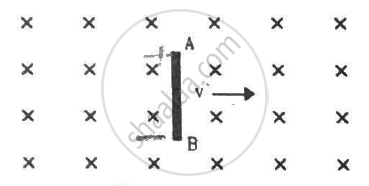
A conducting circular loop of area 1 mm2 is placed coplanarly with a long, straight wire at a distance of 20 cm from it. The straight wire carries an electric current which changes from 10 A to zero in 0.1 s. Find the average emf induced in the loop in 0.1 s.
A square-shaped copper coil has edges of length 50 cm and contains 50 turns. It is placed perpendicular to a 1.0 T magnetic field. It is removed from the magnetic field in 0.25 s and restored in its original place in the next 0.25 s. Find the magnitude of the average emf induced in the loop during (a) its removal, (b) its restoration and (c) its motion.
The north pole of a magnet is brought down along the axis of a horizontal circular coil (see the following figure). As a result, the flux through the coil changes from 0.35 weber to 0.85 weber in an interval of half a second. Find the average emf induced during this period. Is the induced current clockwise or anticlockwise as you look into the coil from the side of the magnet ?
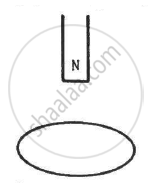
A uniform magnetic field B exists in a cylindrical region of radius 10 cm as shown in figure. A uniform wire of length 80 cm and resistance 4.0 Ω is bent into a square frame and is placed with one side along a diameter of the cylindrical region. If the magnetic field increases at a constant rate of 0.010 T/s, find the current induced in the frame.

Figure shows a circular coil of N turns and radius a, connected to a battery of emf εthrough a rheostat. The rheostat has a total length L and resistance R. the resistance of the coil is r. A small circular loop of radius a' and resistance r' is placed coaxially with the coil. The centre of the loop is at a distance x from the centre of the coil. In the beginning, the sliding contact of the rheostat is at the left end and then onwards it is moved towards right at a constant speed v. Find the emf induced in the small circular loop at the instant (a) the contact begins to slide and (b) it has slid through half the length of the rheostat.
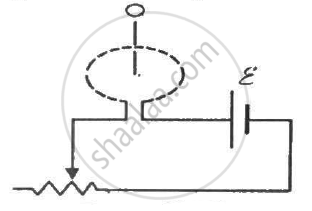
A closed coil having 100 turns is rotated in a uniform magnetic field B = 4.0 × 10−4 T about a diameter which is perpendicular to the field. The angular velocity of rotation is 300 revolutions per minute. The area of the coil is 25 cm2 and its resistance is 4.0 Ω. Find (a) the average emf developed in half a turn from a position where the coil is perpendicular to the magnetic field, (b) the average emf in a full turn and (c) the net charge displaced in part (a).
The two rails of a railway track, insulated from each other and from the ground, are connected to a millivoltmeter. What will be the reading of the millivoltmeter when a train travels on the track at a speed of 180 km h−1? The vertical component of earth's magnetic field is 0.2 × 10−4 T and the rails are separated by 1 m.
A copper wire bent in the shape of a semicircle of radius r translates in its plane with a constant velocity v. A uniform magnetic field B exists in the direction perpendicular to the plane of the wire. Find the emf induced between the ends of the wire if (a) the velocity is perpendicular to the diameter joining free ends, (b) the velocity is parallel to this diameter.
Figure shows a long U-shaped wire of width l placed in a perpendicular magnetic field B. A wire of length l is slid on the U-shaped wire with a constant velocity v towards right. The resistance of all the wires is r per unit length. At t = 0, the sliding wire is close to the left edge of the U-shaped wire. Draw an equivalent circuit diagram, showing the induced emf as a battery. Calculate the current in the circuit.
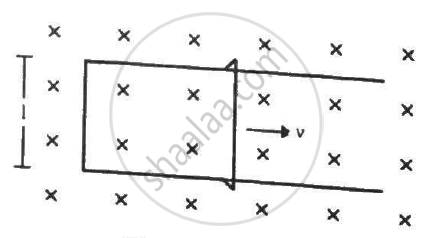
The current generator Ig' shown in figure, sends a constant current i through the circuit. The wire cd is fixed and ab is made to slide on the smooth, thick rails with a constant velocity v towards right. Each of these wires has resistance r. Find the current through the wire cd.
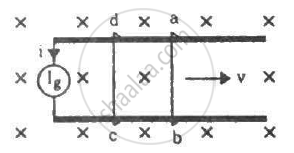
A bicycle is resting on its stand in the east-west direction and the rear wheel is rotated at an angular speed of 100 revolutions per minute. If the length of each spoke is 30.0 cm and the horizontal component of the earth's magnetic field is 2.0 × 10−5 T, find the emf induced between the axis and the outer end of a spoke. Neglect centripetal force acting on the free electrons of the spoke.
The magnetic field in a region is given by \[\overrightarrow{B} = \overrightarrow{k} \frac{B_0}{L}y\] where L is a fixed length. A conducting rod of length L lies along the Y-axis between the origin and the point (0, L, 0). If the rod moves with a velocity v = v0 \[\overrightarrow{i},\] find the emf induced between the ends of the rod.
A uniform magnetic field B exists in a cylindrical region, shown dotted in figure. The magnetic field increases at a constant rate `(dB)/(dt).` Consider a circle of radius r coaxial with the cylindrical region. (a) Find the magnitude of the electric field E at a point on the circumference of the circle. (b) Consider a point P on the side of the square circumscribing the circle. Show that the component of the induced electric field at P along ba is the same as the magnitude found in part (a).

Two identical coaxial coils P and Q carrying equal amount of current in the same direction are brought nearer. The current in ______.
